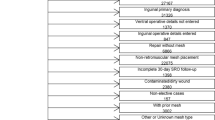Abstract
Background
Retromuscular drains are commonly placed during retromuscular hernia repair (RHR) to decrease postoperative wound complications and help mesh in-growth. Drains are traditionally removed when output is low but the relationship between drain output at the time of removal and postoperative complications has yet to be delineated. This study aimed to investigate outcomes of RHR patients with drain removal at either high or low output volume.
Methods
An institutional review board-approved retrospective chart review evaluated adult patients undergoing open RHR with retromuscular drain placement between 2013 and 2022 at a single academic medical center. Patients were stratified into low output drainage (LOD, < 50 mL/day) or high output drainage (HOD, ≥ 50 mL/day) groups based on volume on the day of drain removal.
Results
We identified 336 patients meeting inclusion criteria: 58% LOD (n = 195) and 42% HOD (n = 141). Demographics and risk factors pertaining to hernia complexity were similar between cohorts. Low-drain output at the time of removal was associated with a significantly longer drain duration (6.3 ± 4.5 vs. 4.4 ± 1.6 days, p < 0.001) and postoperative hospital stay (5.9 ± 3.6 vs. 4.8 ± 2.8 days, p < 0.001). With a 97% 30-day follow-up, incidence of surgical site occurrence (SSO) was not statistically different between groups (29.2% LOD, 26.2% HOD, p = 0.63). Surgical site infection and SSO requiring procedural intervention was also not statistically significant between cohort. At 1-year follow-up, hernia recurrence rates were the same between groups (4.2% LOD, 1.4% HOD, p = 0.25).
Conclusion
Following open ventral hernia repair with retromuscular mesh placement, the rate of postoperative wound complications was not statistically different based on volume of drain output day of removal. These results suggest that removing drains earlier despite higher output is safe and has no effect on short- or long-term hernia outcomes.

Similar content being viewed by others
References
Novitsky YW, Elliott HL, Orenstein SB, Rosen MJ (2012) Transversus abdominis muscle release: a novel approach to posterior component separation during complex abdominal wall reconstruction. Am J Surg 204(5):709–716
Pauli EM, Rosen MJ (2013) Open ventral hernia repair with component separation. Surg Clin North Am 93(5):1111–1133
Gurusamy K, Allen VB (2013) Wound drains after incisional hernia repair. Cochrane Database System Rev (12):CD005570. https://doi.org/10.1002/14651858.CD005570.pub4
Krpata DM, Prabhu AS, Carbonell AM, Haskins IN, Phillips S, Poulose BK, Rosen MJ (2017) Drain placement does not increase infectious complications after retromuscular ventral hernia repair with synthetic mesh: an AHSQC analysis. J Gastrointest Surg 21(12):2083–2089
Kushner B, Smith E, Han B, Otegbeye E, Holden S, Blatnik J (2021) Early drain removal does not increase the rate of surgical site infections following an open transversus abdominis release. Hernia 25(2):411–418
Plymale MA, Harris JW, Davenport DL, Smith N, Levy S, Roth JS (2016) Abdominal wall reconstruction: the uncertainty of the impact of drain duration upon outcomes. Am Surg 82(3):207–211
DeBord J, Novitsky Y, Fitzgibbons R (2018) SSI, SSO, SSE, SSOPI: the elusive language of complications in hernia surgery. Hernia 22:737–738
Scevola S, Youssef A, Kroll SS (2002) Drains and seromas in TRAM flap breast reconstruction. Ann Plast Surg 48:511–514
Tabaqchali MA, Hanson JM, Proud G (1999) Drains for thyroidectomy/parathyroidectomy: fact or fiction? Ann R Coll Surg Engl 81:302–305
Author information
Authors and Affiliations
Corresponding author
Ethics declarations
Disclosures
Charlotte M. Horne is a lecturer for Medtronic and Bard Davol. Eric M. Pauli is a lecturer for Becton–Dickinson and Medtronic, he is a consultant for Boston Scientific, Actuated Medical, Cook Biotech, Neptune Medical, Surgimatix, Noah Medical, Allergan, Intuitive Surgical. Integra, and Steris, receives royalties from UpToDate (Wolters Kluwer) and Springer, and has financial interests in IHC Inc, Contamination Source Identification, and Cranial Devices Inc. Andrea M. Meyer, Antoinette Hu, Alexander T. Liu, Diane H. Jang, Rolfy A. Perez Holguin, Colin G Delong have no conflicts of interest or financial ties to disclose.
Additional information
Publisher's Note
Springer Nature remains neutral with regard to jurisdictional claims in published maps and institutional affiliations.
Rights and permissions
Springer Nature or its licensor (e.g. a society or other partner) holds exclusive rights to this article under a publishing agreement with the author(s) or other rightsholder(s); author self-archiving of the accepted manuscript version of this article is solely governed by the terms of such publishing agreement and applicable law.
About this article
Cite this article
Meyer, A.M., Hu, A., Liu, A.T. et al. Retromuscular drain output at removal does not influence adverse outcome rate in open ventral hernia repairs. Surg Endosc 38, 356–362 (2024). https://doi.org/10.1007/s00464-023-10428-9
Received:
Accepted:
Published:
Issue Date:
DOI: https://doi.org/10.1007/s00464-023-10428-9




